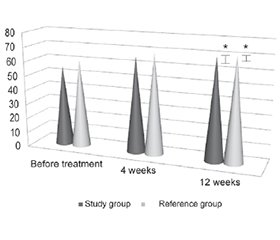Международный неврологический журнал Том 21, №6, 2025
Вернуться к номеру
Гостра мієлоїдна лейкемія, що супроводжується синдромом хронічної втоми: стратегія відновлення
Авторы: H.I. Moroz, O.V. Kucher
Shupyk National Healthcare University of Ukraine, Kyiv, Ukraine
Рубрики: Неврология
Разделы: Клинические исследования
Версия для печати
Актуальність. Клінічні дані свідчать на користь того, що у хворих на гостру мієлоїдну лейкемію (ГМЛ) доволі розповсюдженим є синдром хронічної втоми (СХВ). Він характеризується одночасним відчуттям стійкої втоми в цілому й різними соматичними симптомами. Мета: вивчити ефективність комплексної ад’ювантної імунокорекції в осіб із ГМЛ та СХВ. Матеріали та методи. Проведене планове лікування 60 хворих на ГМЛ (37 жінок та 23 чоловіків віком від 29 до 59 років), яким був діагностований СХВ. Перед початком лікування, через один і три місяці проводили моніторинг імунологічних показників, рівня вітаміну D та клінічних проявів СХВ. Для вивчення ефективності комплексної імунокорекції пацієнтів розділили на 2 групи. У групу дослідження (n = 30) увійшли хворі, які отримували базову терапію ГМЛ (даунорубіцин 45 або 90 мг/м2, цитарабін 100 мг/м2 п/ш) та додатково — схему підтримки імунітету: вітамін D (4000 МО 1 раз на добу), ресвератрол (250 мг 1 раз на добу) та екстракт молозива у капсулах (400 мг 2 рази на добу). У групу порівняння (n = 30) були включені пацієнти, яким призначили аналогічну схему лікування, але без екстракту молозива. Результати. Порівняно з референтною групою запропонований терапевтичний сценарій приводить до більш значущого стимулюючого впливу на активність клітинного та гуморального імунітету пацієнтів: збільшення кількості Т-лімфоцитів хелперів і цитотоксичних лімфоцитів CD8, питомої ваги активованих Т-клітин з одночасним збільшенням кількості Т-кілерів CD18 та вірогідним підвищенням концентрації імуноглобуліна А (p < 0,05). Обрана схема імунокорекції також обумовлює краще регресування клінічної симптоматики СХВ. Висновки. Комбінація ресвератролу, вітаміну D та екстракту молозива сприяє більш значущому стимулюючому впливу на активність клітинного і гуморального імунітету пацієнтів, а також кращому регресуванню клінічної симптоматики СХВ порівняно з референтною групою.
Background. Clinical data suggest that chronic fatigue syndrome (CFS) is quite common in patients with acute myeloid leukemia (AML). CFS is characterized by a simultaneous feeling of persistent fatigue in general and various somatic symptoms. The purpose was to study the effectiveness of comprehensive adjuvant immunocorrection in AML patients with CFS. Materials and methods. A planned treatment was performed in 60 AML patients (37 women and 23 men aged 29 to 59 years) who were diagnosed with CFS. At baseline, after one and three months, patients were monitored for immunological parameters, vitamin D levels and clinical manifestations of CFS. To study the effectiveness of comprehensive immunocorrection, patients were divided into 2 groups. The study group (n = 30) included those who received basic AML therapy (daunorubicin 45 or 90 mg/m2, cytarabine 100 mg/m2 u/s) and additionally an immune support regimen: vitamin D (4000 IU 1 time per day), resveratrol (250 mg once daily) and colostrum extract in capsules 400 mg 2 times per day. The comparison group (n = 30) included patients who were prescribed a similar treatment regimen, but without the administration of colostrum extract. Results. The results of the study indicate in favor of integrating a probiotic complex into the immunocorrection regimen of patients with AML accompanied by CFS. Indeed, compared to the reference group, the proposed therapeutic scenario leads to a more significant stimulating effect on the activity of cellular and humoral immunity of patients: an increase in the number of T-helper lymphocytes and cytotoxic CD8 lymphocytes, in the specific gravity of activated T-cells with a simultaneous increase in the number of CD18 T-killers and a significant increase in the concentration of immunoglobulin A (p < 0.05). The selected immunocorrection scheme also causes better dynamics of regression of clinical symptoms of CFS. Conclusions. The proposed therapeutic scenario of resveratrol, vitamin D and colostrum extract combination leads to a more significant stimulating effect on the activity of cellular and humoral immunity of patients and also causes better dynamics of CFS clinical symptoms regression compared to the reference group.
гостра мієлоїдна лейкемія; бласти; цитопенія; анемія; синдром дисемінованого внутрішньосудинного згортання; коагулограма; фактор фон Віллебранда; синдром хронічної втоми; ресвератрол; вітамін D; екстракт молозива; імунокорекція
acute myeloid leukemia; blasts; cytopenia; anemia; disseminated intravascular coagulation syndrome; coagulogram; von Willebrand factor; chronic fatigue syndrome; resveratrol; vitamin D; colostrum extract; immunocorrection

